Fun with Music: Voices
This post, “Fun with Music – Sting Instruments”, is written in collaboration with Shannon Wijnker, who used to blog on Mamamusing. Shannon is a music teacher and mother of four.
Shannon writes:
Many parents want to give their children the gift of music, but don’t know where to start. I think that teaching children how to explore their voice and singing is so easy and something that every parent can encourage. And it doesn’t have to cost a cent!
Content:
Playtime
Craft
Musical Outings
Story Time
Games Online
Related Posts
Playtime
More from Shannon:
I wrote a post about Music at an Early Age, and in my post I touch on my philosophy about educating our children to be musical.
It is never too early to start building a foundation that facilitates musical proficiency. Babies and toddlers learn about music by first learning about sound. They experiment with their voices make different sounds of varying volumes. While many parents will recognize this as ‘noise’ it is a great first step. Encourage them to explore various ways to make sounds with their mouths and talk about how to modulate their volume.
A tip: I teach my students to put their fingers against their windpipe. If they whisper they don’t feel a vibration. If they are talking or shouting, then they will feel a vibration. This helps to build the concept of volume.
Also, let them experiment with their voice. Children will naturally do this, so let them feel free to explore. Though some encouragement, they will create their own songs about random subjects. (The other day my daughter sang about how she was sorry for hitting her sister after she was let out of time out).
Visit my blog I mentioned earlier to watch a video of my 18 month old experimenting with her voice in the car.
Children learn best thru example and modeling. That means that you need to show them that you enjoy listening to music and/or singing. If you aren’t prepared to sing with your kids, then make sure to play a CD or two repetitively so they can learn the songs. Children need to hear songs that only have a few notes. Not pop songs! Learning these songs also helps with language acquisition, because they are learning rhyme. Don’t overwhelm them with too many songs. They will only feel comfortable trying to sing, once they know a song inside and out. You cannot play a song too much for a child. If you’re getting sick of it, they are just beginning to memorize/internalize it!
Echo songs are also a great idea. Small pieces of melody are easier to learn, and they foster a musical independence. Many children will only sing with a recording, and they need to be confident with their own voice. (eg. Down By the Bay)
A common complaint by many adults is that they are simply ‘tone deaf’. I disagree. They are not tone deaf, but did not develop the proper muscles to sing in tune. Trying to sing up a scale is very difficult for a child. It is much easier for them to start high and sing down. If you pay attention, many children’s songs have a lot of descending passages because of this. Until the muscles develop (you can work on these muscles by singing, and by starting from a high note and singing to a low note), singing outside of a notes which are naturally comfortable will result in ‘out-of-tune-ness’.
Some exercises:
· Sigh from the top of your voice to the bottom (test how high/low you can go)
· Use sounds such as “mmmm” “zzzz” “vvvv”
· Sing lying on the floor
· Make “siren” noises without straining
· Teach them to match pitch by singing back the note you are singing
· Have them follow your hand up and down with their voice (or draw their name while following the hand with their voice!) – this may take some practice
· Have them hum and get them to recognize that sensation when they sing
Remember that kids learn best by doing, not by being told how to do something. When they lose interest, move on and try again another time. Children learn best by repetition. Also, songs are much more fun with movement and actions. Have fun!
Craft
Microphone
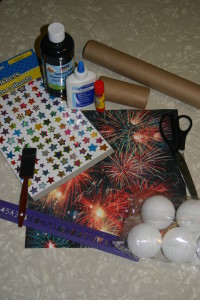
Materials Needed:
Empty paper towel roll or toilet paper roll
Small styrofoam ball – 2 1/2 inches (63 mm)
Fancy scrapbook paper, construction paper or paint
White craft glue
Decorations (sparkly stickers, foam stickers, markers, etc)
Instructions:
1) Cover the workspace. I used parchment paper because I was able to get it cheap at the Dollar Tree Store. And cover the child. I found an old tee shirt.
2) I cut a ring from a toilet paper roll to set the styrofoam ball on so that it wouldn’t roll away.
3) Paint the styrofoam ball black or silver. I like to use foam applicators for painting large surfaces. The most difficult part of painting the ball was learning that its okay to get your fingers messy.
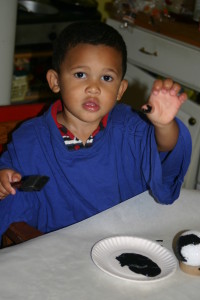
But he got used to it and enjoyed the painting.
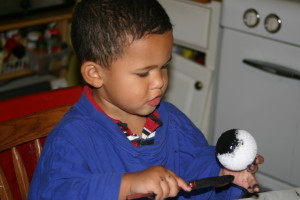
4) We are making two microphones; one from a paper towel roll and one from a toilet paper roll. I couldn’t decide which would be better for a 2 year old so we made both.
5) You can decorate the rolls however you like. You could paint them but I decided to use a fancy piece of scrapbook paper. I cut it to fit each roll.
6) We glued the paper and then applied it to the rolls. Jeremiah used the glue stick and then I added some white craft glue for extra adhesion.
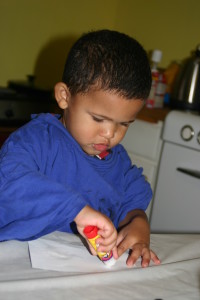
7) Jeremiah added some stickers because stickers are fun and they are a great fine motor exercise.
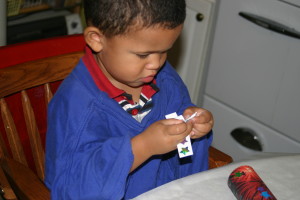
8) Finally we attached the balls to the top. Make sure to use a thick craft glue. I ended up adding some super glue but super glue should be used with caution and by adults only.
9) Now we can enjoy using our voices by singing into our microphones. The toilet paper size was better for little hands but the paper towel roll was a great size for older kids.

This microphone craft was adapted from itmom.
Musical Outings
Take your children to any place that live music is being played. In Indianapolis, you can find many places that give free outdoor concerts during the summer. Maybe you have the same opportunities in your area. Outdoor concerts are a great way to introduce your children to live music because they can sit in their own lawn chair, on a blanket or even get up and dance around a little. Maybe you have older children or neighbors that participate in a school band. Take your children to see them. Expose your children to many types of music. Take the time to talk about what they are hearing, how it makes them feel and the different instruments they are seeing and hearing.
Shannon from Mamamusing wants you to know: “In London, there are several outdoor concerts and festivals in Victoria Park during the summer. One of the best is Sunfest (beginning of July). You can check out a video of my kids enjoying the multicultural music and dancing byclicking here.”
Storytime
Freddie the Frog® and the Flying Jazz Kitten – 5th Adventure: Scat Cat Island
by Sharon Burch
Reading Level: Ages 4 – 9 yrs old
Freddie the Frog meets the Flying Jazz Kitten and learns about wonderful new ways to use his voice. The Flying Jazz Kitten teaches Freddie the Frog the swingin’ beat and excitement of jazz scat singing. There is also a CD with the dramatized story, sing-along songs and an instrumental blues track to create your own special scat.
The Voice and Singing (Let’s Make Music)
by Rita Storey
Reading Level: Ages 6 yrs old and up
Each person carries around a special instrument with them wherever they go; their voice. Your child will enjoy learning about their voice in this cute informational book. In simple descriptions, they will learn how their voice works. They will learn about many different styles of singing and different ways they can enjoy singing. Whether they are listening to others sing or using their own voices, singing is fun.
Voices (Instruments and Music)
by Daniel Nunn
Reading Level: Ages 4 to 8 yrs old
An instrument that we don’t discuss very often is the voice. This book describes how people use their voices to make music. Sometimes they are accompanied by another instrument or other voices. Sometimes they sing all alone. Share this book with your child and help them learn how their voice is an instrument to enjoy.
Voices and Singing (How the World Makes Music)
by Anita Ganeri
Reading Level: Ages 6 and up
This book covers voices as a musical instrument. Your child will learn about many styles of singing from all over the world. The way people use their voices from other parts of the world can sound very different than what we are used to hearing. Along with reading this book take some time to look on the internet and find examples of the different ways people use their voices, such as jazz singing, gospel singing, throat singing and yodeling. How do you and your children use your voices to make music?
Games Online
Shannon from Mamamusing shares some fun online games:
Now that you have introduced your children to some of the various instrument families in the orchestra, you may want to visit The Young Person’s Guide to the Orchestra. This is a website created by Carnegie Hall which is a wonderfully FREE interactive online game for young children to explore and learn more about the various instruments of the orchestra. You will need to use a computer, because the game requires Adobe Flash, which you can download for free (if you don’t already have this utility installed on your computer).
There is also a wonderful set of books for children ages 4 to 8 years old that helps them learn different musical concepts. Along with the books the author, Sharon Burch, has a website with coloring pages and games for your child to enjoy and enhance their learning experience: Freddie the Frog Games and Coloring Pages
Related Posts
Music at an Early Age by Shannon at Mamamusing
Fun with Music – Overview
Fun with Music – Percussion Instruments
Fun with Music – Brass Instruments
Fun with Music – Woodwind Instruments
Fun with Music: String Instruments
Fun with Music: Keyboards



